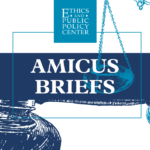If Synod-2023 concludes in such a way that the discussion of an “issue” that seems to be a non-issue remains alive between now and Synod-2024, then a disservice will have been done to the Church, and a great deal of precious time that could have been spent on advancing the New Evangelization will have been wasted.

Published October 18, 2023
The Issue, or Non-Issue, of Women Deacons
On Monday, October 16, several small discussion groups reported to the Synod general assembly that their “Conversations in the Spirit” had included calls for the ordination of women to the diaconate or further examination of this question. Because of the Synod’s reporting methodology, there was no indication of what degree of support these proposals had, whether they came from clergy or laity, or whether the discussions that generated such proposals had been framed in sociological or theological terms. Moreover, according to the Synod’s general assembly process, there was no opportunity for serious engagement with, or critique of, these proposals. They were simply reported as having been discussed; and it may be assumed that such discussions, however marginal or ill-conceived, will be noted in the Synod’s Final Synthesis as having taken place.
This episode further illustrated the curious—some might say, bizarre—synodal work process underway in Rome this month, where anything may be said and must be noted as having been said, because it is presumed, at least in principle, that anything that may be said may be Spirit-inspired.
As to the substance of the matter, however, some observations, based on reading Vatican II’s Lumen Gentium in tandem with John Paul II’s apostolic letter Ordinatio Sacerdotalis, may be useful.
1) In its Dogmatic Constitution on the Church, Lumen Gentium, the Second Vatican Council taught that the ministry of Christ continues in the Church’s ordained ministry, which is “exercised on different levels by those who from antiquity have been called bishops, priests, and deacons.” That teaching involved the restoration in Latin-rite Catholicism (long sought by Catholic reformers) of an ancient Christian tradition that had never been lost in the Christian East, according to which the diaconate is a genuine “order” in the sacred ministry, not merely a stepping-stone to the priesthood.
2) The sacred ministry is transmitted over time through the divinely instituted sacrament of Holy Orders. Just as there is one sacred ministry in the Church, there is one sacrament of Holy Orders, which is conferred on bishops, priests, and deacons in different grades or degrees.
3) In the 1994 apostolic letter Ordinatio Sacerdotalis (Priestly Ordination), Pope John Paul II definitively taught that the Church has no authority to confer priestly ordination on women through the sacrament of Holy Orders. And if, as Lumen Gentium taught, the ordained priesthood is part of a sacred ministry composed of priests, bishops, and deacons, then the fact that the Church has no authority to confer priestly ordination on women would seem to mean that the Church, preserving the unity of one Order in three degrees, has no authority to confer episcopal or diaconal ordination on women.
4) That the teaching of Ordinatio Sacerdotalis is to be regarded as an irreformable part of the Deposit of Faith was confirmed by the Congregation for the Doctrine of the Faith in a formal response to a question (dubium) posed in the wake of John Paul II’s apostolic letter.
5) The question of whether the Church has the authority to ordain women to the diaconate, as the diaconate is understood according to the ancient tradition of the Church, would thus seem to be a non-question. So further discussion of this matter is a distraction from the serious issues of communion, participation, and mission with which this Synod is supposed to be wrestling.
Some further observations:
* There seems little doubt that, given the pattern set by the Anglican Communion and others, the pressure within the Catholic Church for the ordination of women as deacons is, for those applying that pressure, a first step toward the ordination of women as priests and, ultimately, bishops. Yet those applying that pressure, toward that end, would seem to be caught in an irresolvable dilemma. If the diaconate is part of the sacred ministry, then the Church would seem to have made it clear that it has no authority to confer the diaconate (or priesthood, or episcopacy) on women through Holy Orders—and to deny that truth is to put oneself in something of a defective state of communion with the Church. If, on the other hand (and for the sake of argument, since the notion is historically absurd), the diaconate is not a part of that sacred ministry, would those pressing for women deacons really be interested?
* This continuing agitation is posing further obstacles to ecumenical reconciliation between Catholicism and Orthodoxy. Is that not a concern?
* The Catholic Church has been called by Pope Francis to rid itself of clericalism, a dysfunction that, rightly understood, is rooted in a distorted notion of Holy Orders as a matter of gaining-power-over-others rather than of being consecrated-for-service-to-others: a misconception that leads in turn to the equally warped notion, rejected by Lumen Gentium in its chapters “On the People of God” and “The Universal Call to Holiness in the Church,” that only those in Holy Orders really matter in Catholicism. Which is to say that there is more than a whiff of clericalism in the agitation for ordaining women as deacons.
* And what, one might ask, about the innumerable ways that women already play culture-transforming roles in the Body of Christ: as wives and mothers, teachers and catechists, nurses and doctors, social workers and pro-bono lawyers, consecrated religious and consecrated laity, theologians and philosophers, parish workers and chancery officials? Are these of no consequence? Are these women “disempowered” by the fact that they cannot be deacons? Please.
* Finally, doesn’t this agitation about women deacons (and, more broadly, women in Holy Orders), constitute a subtle form of disrespect to the Mother of the Church, the Blessed Virgin Mary? She was not in Holy Orders. Yet she is, according to Vatican II, the very pattern and model of the Church. Thus the many beautiful icons of the “Dormition” of Our Lady—where Mary, at the end of her earthly journey and immediately prior to her Assumption, is surrounded by the apostles—illustrates that fundamental truth of Catholic faith: Mary has no need of ordination; she has other and higher powers that come from the sanctity that a radical Fiat (“Be it done unto me according to your word” [Luke 1:38]) makes possible.
George Weigel
The Key Texts
The Key Texts
Lumen Gentium (The Dogmatic Constitution on the Church of the Second Vatican Council)
28. Christ, whom the Father has sanctified and sent into the world, has through His apostles, made their successors, the bishops, partakers of His consecration and His mission. They have legitimately handed on to different individuals in the Church various degrees of participation in this ministry. Thus the divinely established ecclesiastical ministry is exercised on different levels by those who from antiquity have been called bishops, priests and deacons . . .
29. At a lower level of the hierarchy are deacons, upon whom hands are imposed “not unto the priesthood, but unto a ministry of service.” For strengthened by sacramental grace, in communion with the bishop and his group of priests they serve in the diaconate of the liturgy, of the word, and of charity to the people of God. It is the duty of the deacon, according as it shall have been assigned to him by competent authority, to administer baptism solemnly, to be custodian and dispenser of the Eucharist, to assist at and bless marriages in the name of the Church, to bring Viaticum to the dying, to read the Sacred Scripture to the faithful, to instruct and exhort the people, to preside over the worship and prayer of the faithful, to administer sacramentals, to officiate at funeral and burial services. Dedicated to duties of charity and of administration, let deacons be mindful of the admonition of Blessed Polycarp: “Be merciful, diligent, walking according to the truth of the Lord, who became the servant of all.”
Since these duties, so very necessary to the life of the Church, can be fulfilled only with difficulty in many regions in accordance with the discipline of the Latin Church as it exists today, the diaconate can in the future be restored as a proper and permanent rank of the hierarchy. It pertains to the competent territorial bodies of bishops, of one kind or another, with the approval of the Supreme Pontiff, to decide whether and where it is opportune for such deacons to be established for the care of souls. With the consent of the Roman Pontiff, this diaconate can, in the future, be conferred upon men of more mature age, even upon those living in the married state. It may also be conferred upon suitable young men, for whom the law of celibacy must remain intact.
Ordinatio Sacerdotalis (Apostolic Letter of Pope John Paul II, May 22, 1994)
4. Although the teaching that priestly ordination is to be reserved to men alone has been preserved by the constant and universal Tradition of the Church and firmly taught by the Magisterium in its more recent documents, at the present time in some places it is nonetheless considered still open to debate, or the Church’s judgment that women are not to be admitted to ordination is considered to have a merely disciplinary force.
Wherefore, in order that all doubt may be removed regarding a matter of great importance, a matter which pertains to the Church’s divine constitution itself, in virtue of my ministry of confirming the brethren (cf. Lk 22:32) I declare that the Church has no authority whatsoever to confer priestly ordination on women and that this judgment is to be definitively held by all the Church’s faithful.
Dubium: Whether the teaching that the Church has no authority whatsoever to confer priestly ordination on women, which is presented in the Apostolic Letter Ordinatio Sacerdotalis to be held definitively, is to be understood as belonging to the deposit of faith.
Responsum: Affirmative.
This teaching requires definitive assent, since, founded on the written Word of God, and from the beginning constantly preserved and applied in the Tradition of the Church, it has been set forth infallibly by the ordinary and universal Magisterium (cf. Second Vatican Council, Dogmatic Constitution on the Church Lumen Gentium 25, 2). Thus, in the present circumstances, the Roman Pontiff, exercising his proper office of confirming the brethren (cf. Lk 22:32), has handed on this same teaching by a formal declaration, explicitly stating what is to be held always, everywhere, and by all, as belonging to the deposit of the faith.
The Sovereign Pontiff John Paul II, at the Audience granted to the undersigned Cardinal Prefect, approved this Reply, adopted in the Ordinary Session of this Congregation, and ordered it to be published.
Rome, from the offices of the Congregation for the Doctrine of the Faith, on the Feast of the Apostles SS. Simon and Jude, October 28, 1995
.Joseph Card. Ratzinger Prefect











